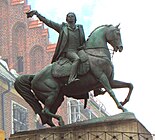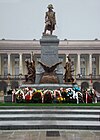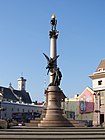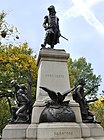Antoni Popiel
Antoni Popiel | |
|---|---|
 Antoni Popiel ca. 1911 | |
| Born | 13 June 1865 Szczakowa, Austria Hungary |
| Died | 7 July 1910 (aged 45) |
| Nationality | Polish |
| Education | Jan Matejko Academy of Fine Arts in Kraków Academy of Fine Arts Vienna |
| Known for | sculpture |
Notable work | Tadeusz Kościuszko Monument, Kraków, 1900 Adam Mickiewicz Column, 1904 Tadeusz Kościuszko Monument, Warsaw, 1910 |
Antoni Popiel (13 June 1865, in Szczakowa, Galicia (now Jaworzno) – 7 July 1910, in Velykyi Liubin near Lviv) was a Polish sculptor.[1][2]
Life[]
He studied at the School of Fine Arts, Kraków from 1882 to 1884, with Izydor Jabłoński, Władysław Łuszczkiewicz and Walery Gadomski. He studied at the Academy of Fine Arts Vienna, from 1885 to 1888.
In 1888, he studied in Berlin and Florence, and returned to Poland. He lived first in Kraków, then in Lviv, including a job as assistant to Leonard Marconi, at the Faculty of Drawing and modeling of the Lviv Polytechnic. He remained connected with it for life. In 1894, he created sculptures decorating the entrance to the Palace of the Arts (Polish: Pałac sztuki) constructed for the General National Exhibition in Lviv.[3] He stayed in Florence, from 1895 to 1897, where he made a statue of Justitia for the lobby of the Palace of Justice in Lviv (1896), and the design of the monument of Józef Korzeniowski, which was then erected in Brody. In 1898, he won a competition for a monument to Adam Mickiewicz University in Lviv. The monument, in the form of a tall column topped with a Torch of Poetry, was unveiled on 30 October 1904.[4] After the death of Leonardo Marconi, Antoni Popiel continued work on the statue of Tadeusz Kosciuszko in Kraków. The monument stood on the Wawel hill. During World War II, in 1940, it was destroyed by the Germans, and reconstructed in 1960.
In 1900, he designed sculptures for the Grand Theatre in Lviv - tympanum, stone caryatids; and statues of the Muses. In 1907, he participated in the competition for a monument to Tadeusz Kosciuszko in Washington, D.C. Although he won second prize, President Theodore Roosevelt selected his design for implementation. Between 1902–1904, he designed the allegorical figures which were placed at the main entrance to the Lviv Railway Station.
His brother was the panorama painter, Tadeusz Popiel.
Death[]
He died on 7 July 1910 in Velykyi Liubin and was buried at the Lychakiv Cemetery in Lviv.
Gallery[]
Kornel Ujejski Monument
References[]
- ^ Biographical notes Archived 18 February 2010 at the Wayback Machine @ Moje Jaworzno.
- ^ "Antoni Sulima Popiel". Retrieved 18 August 2019.
- ^ "The Pavilions of the Galician General Regional Exhibition of 1894". Retrieved 22 December 2020.
- ^ "PL. MICKIEWICZA – POMNIK ADAMA MICKIEWICZA". Retrieved 18 August 2019.
External links[]
- "Antoni Popiel", Polish wikipedia
- Polish sculptors
- 1865 births
- 1910 deaths
- People from Jaworzno
- 20th-century sculptors
- 19th-century sculptors
- Polish artist stubs
- European sculptor stubs




